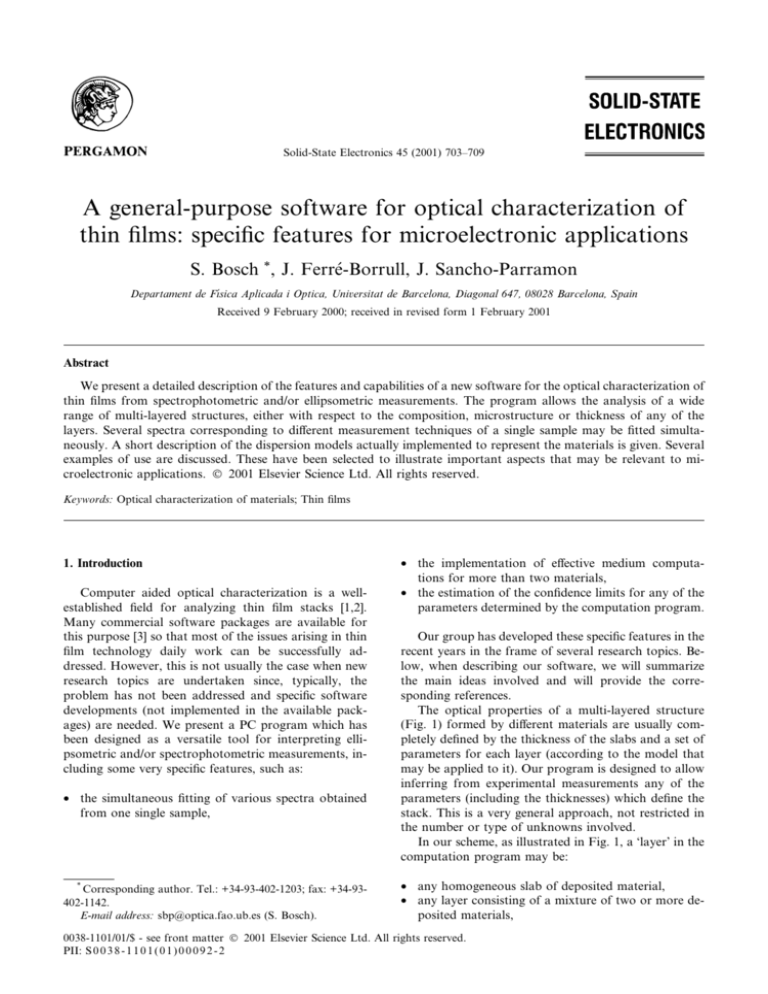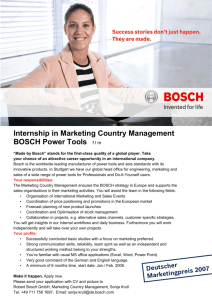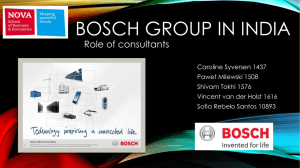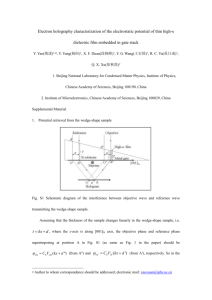
Solid-State Electronics 45 (2001) 703±709
A general-purpose software for optical characterization of
thin ®lms: speci®c features for microelectronic applications
S. Bosch *, J. Ferre-Borrull, J. Sancho-Parramon
Departament de Fõsica Aplicada i Optica, Universitat de Barcelona, Diagonal 647, 08028 Barcelona, Spain
Received 9 February 2000; received in revised form 1 February 2001
Abstract
We present a detailed description of the features and capabilities of a new software for the optical characterization of
thin ®lms from spectrophotometric and/or ellipsometric measurements. The program allows the analysis of a wide
range of multi-layered structures, either with respect to the composition, microstructure or thickness of any of the
layers. Several spectra corresponding to dierent measurement techniques of a single sample may be ®tted simultaneously. A short description of the dispersion models actually implemented to represent the materials is given. Several
examples of use are discussed. These have been selected to illustrate important aspects that may be relevant to microelectronic applications. Ó 2001 Elsevier Science Ltd. All rights reserved.
Keywords: Optical characterization of materials; Thin ®lms
1. Introduction
Computer aided optical characterization is a wellestablished ®eld for analyzing thin ®lm stacks [1,2].
Many commercial software packages are available for
this purpose [3] so that most of the issues arising in thin
®lm technology daily work can be successfully addressed. However, this is not usually the case when new
research topics are undertaken since, typically, the
problem has not been addressed and speci®c software
developments (not implemented in the available packages) are needed. We present a PC program which has
been designed as a versatile tool for interpreting ellipsometric and/or spectrophotometric measurements, including some very speci®c features, such as:
· the simultaneous ®tting of various spectra obtained
from one single sample,
*
Corresponding author. Tel.: +34-93-402-1203; fax: +34-93402-1142.
E-mail address: sbp@optica.fao.ub.es (S. Bosch).
· the implementation of eective medium computations for more than two materials,
· the estimation of the con®dence limits for any of the
parameters determined by the computation program.
Our group has developed these speci®c features in the
recent years in the frame of several research topics. Below, when describing our software, we will summarize
the main ideas involved and will provide the corresponding references.
The optical properties of a multi-layered structure
(Fig. 1) formed by dierent materials are usually completely de®ned by the thickness of the slabs and a set of
parameters for each layer (according to the model that
may be applied to it). Our program is designed to allow
inferring from experimental measurements any of the
parameters (including the thicknesses) which de®ne the
stack. This is a very general approach, not restricted in
the number or type of unknowns involved.
In our scheme, as illustrated in Fig. 1, a `layer' in the
computation program may be:
· any homogeneous slab of deposited material,
· any layer consisting of a mixture of two or more deposited materials,
0038-1101/01/$ - see front matter Ó 2001 Elsevier Science Ltd. All rights reserved.
PII: S 0 0 3 8 - 1 1 0 1 ( 0 1 ) 0 0 0 9 2 - 2
704
S. Bosch et al. / Solid-State Electronics 45 (2001) 703±709
there are many models to describe its optical behavior,
depending mainly on the type of material (dielectric,
metal or semiconductor) and spectral range considered.
On the other hand, in the case of the ``subsequent''
layers it is customary to model them within the sample
by means of eective medium approximation (EMA)
theories (see below for a short description). From the
point of view of computations, a model is, simply, a
dispersion formula for n and k, the real and imaginary
part of the complex refractive index of the material. We
now brie¯y outline the models implemented in our
program, with a more detailed description of our recent
contributions.
Fig. 1. Sketch of a multi-layered sample.
· any interface between deposited layers,
· a thin slab representing the roughness of the outermost surface.
The ®rst two possibilities correspond to ``production'' layers, this is, layers intentionally manufactured.
On the other hand, the two last possibilities correspond
to ``subsequent'' layers, which appear later on (intentionally or not) in the stack because of interdiusion of
material between layers, the roughness in the substrate
or layers, etc.
In our computation procedures the contribution of
the two sides of the substrate can be taken into account
by considering that the light beams re¯ected at the two
faces are added on an intensity (incoherent) basis, rather
than on an amplitude (coherent) superposition, as required for the layers. Moreover, the substrate can be
considered semi-in®nite as well, this is, without including the backside re¯ections. This is adequate for the
cases where the backside of the substrate is grinded, as
customary in ellipsometry, or when substrates are highly
absorbing. The computations allow any incidence angle
and, in case of spectrophotometric data, these can correspond to p, s or `natural' polarization.
2. Modeling the layers: detailed description
Our goal is the precise optical characterization of a
layered structure for a certain wavelength (or photon
energy) range. We have already mentioned that the very
de®nition of the structure is usually not straightforward,
since not only the layers intentionally produced are
present but also other layered interfaces may exist. As
mentioned, some of the possibilities are: interdiusion of
materials, roughness, porosity... It is the task of the
physicist or engineer to elucidate what is the right
structure to be proposed to accurately represent the
samples under analysis. For the ``production'' layers,
2.1. Cauchy model (with exponential absorption)
It is useful for dielectric materials, far from the absorption bands [4]. The formulae are:
n1 n2
k1
n
k n0 2 4 ;
:
1
k
k k0 exp
k
k
k
Note that this model is de®ned by ®ve parameters n0 , n1 ,
n2 , k0 and k1 .
2.2. Sellmeier model
It is very similar to the previous one. The formulae
are:
s
A1 k2
n
k 1 2
;
k
k 0;
2
k
A2
that include only two parameters A1 and A2 .
2.3. Lorentz oscillator
This is the most fundamental description of a dielectric material within the electromagnetic theory [4].
The refractive indices are (in terms of the wavenumber
r):
i1=2
h p
n
r 12
;
e02 e002 e0
i1=2
h p
k
r 12
;
3a
e02 e002 e0
e00 2nk;
e0 n 2
k2 ;
e0 e1
F
r20
r20 r2 2
2
e00
r
Cr2
F
Cr
r20
e e0 ie00 ;
r2 2
Cr2
;
;
C
F
e0
c
;
2pc
3b
e1 r20 :
Several oscillators can be simultaneously considered.
The required parameters are e1 plus three quantities
F ; C; r0 for each oscillator.
S. Bosch et al. / Solid-State Electronics 45 (2001) 703±709
2.4. Tauc±Lorentz expressions
This dispersion model has been successfully used for
amorphous semiconductors and insulators [5] and is a
generalization of previous theoretical approaches like
the Tauc model [6] and the Forouhi±Bloomer parametrization [7]. It is, in fact, a modi®cation of the Lorentz
oscillator just presented above and a practical comparison between these models has been recently presented
for amorphous carbon ®lms [8]. The mathematical expressions involved are really cumbersome [5] and will
not be presented here explicitly.
2.5. Bruggeman eective medium approximation
In the case of layers that can be considered a mixture
of materials, the electromagnetic description can be
done in terms of an EMA [9]. As a consequence, besides
the representation of actual mixtures of components, in
the framework of our computation approach, the EMA
will enable us to model interfacial layers (i.e., zones
where one can assume to have a mixture of the materials
from two consecutively deposited layers) as well as
roughness (where air is mixed with the material of the
top layer). Historically, the ®rst EMA theory was developed by Bruggeman [10]. The resulting optical constants will depend mainly on the volume fraction of the
components (host material and inclusions). Nevertheless,
the geometrical con®guration of the mixture (shape or
type of inclusions within a host material) is also relevant
and may be introduced in a generalised EMA theory by
including a screening parameter y [11]. If we name ei the
dielectric constants of the components, fi their volume
fractions and y the screening parameter, the mathematical expression for the eective dielectric constant e
in terms of the ei , fi and y is given (in implicit form) by
X ei e
:
4
0
fi
ei ye
i
2.6. Lorentz±Lorenz eective medium approximation
This approximation diers from the Bruggeman
theory in the consideration of what is the host material
and what are the inclusions. Now the eective dielectric
constant is given by
e 1 X ei 1
fi
:
5
e y
ei y
i
Major computational problems arise when more than
two materials are present in a mixture, since (in the
spectroscopic case) Eqs. (4) and (5) have to be solved for
each wavelength starting from the spectral data of the
individual components, with only an approximate
knowledge of their volume fractions. A convenient nu-
705
merical procedure to deal with the last two equations
has been recently developed in Ref. [12]. It is important
to note that the methods presented in this reference
provide a suitable computational framework for all the
practical situations that can be modeled through EMA
theories involving more than two constitutive materials,
like considering a super®cial roughness (represented as a
void fraction) on a two-material mixture layer, for example.
3. Computational scheme
According to the modeling of the layers just exposed,
®nally each layer can be fully described by its geometrical thickness and a set of variable number of parameters, according to the complexity of the model we are
considering for it. The complete stack (including the
substrate) is de®ned by the full set of model parameters
and thicknesses. In practical situations, some of these
values will be known (for example the optical constants
of the substrate), while others are only approximately
estimated and will be the unknowns of our characterization process.
There is one main dierence between a numerical
procedure developed for a speci®c problem and a general-purpose software: in this second case the computational scheme must be broad enough to cover all the
conceivable cases. We have been involved in recent years
in a series of investigations about monochromatic ellipsometry [13±16], spectroscopic ellipsometry [17±19]
and spectrophotometry [20±22], providing (in all the
cases) some speci®c new ideas which have been the basis
for the work we are presenting now.
Our computational approach is as follows. Assume,
®rst, that our data consist of a single set of n measurements yi , i 1; . . . ; n, corresponding to the independent
variables xi (say, for example, an spectrum of re¯ectance
values yi at normal incidence for wavelengths xi ). Once
all the de®ning parameters (say m quantities in total: p1 ,
p2 ,. . .,pm ) take a value and assuming that we have an
estimation of the error ri associated to each single data
yi , standard thin ®lm computation procedures [2] allow
us to compute the chi-square function
v2
p1 ; p2 ; . . . ; pm
n
1
m 1
n X
yi
i1
y
xi ; p1 ; p2 ; . . . ; pm
ri
2
:
6
This will be the merit function in a minimization procedure in the space of the unknown parameters. We still
have to choose the minimization algorithm: we use the
`Downhill Simplex' method [23] because is very easy to
adapt to our situation where the number of unknowns
706
S. Bosch et al. / Solid-State Electronics 45 (2001) 703±709
and the range of their increments are quite variable.
Moreover, the explicit dependence between v2 and the
parameters is usually very complex, so that other algorithms (such as those requiring the computation of derivatives) are inappropriate. The optimization is started
from the point in the parameter space de®ned by the
estimated values (guess) of the unknown parameters.
Once the optimization is done our numerical procedures also include the computation of the correlated and
uncorrelated con®dence limits for the calculated parameters. These tasks require knowing the curvature
matrix (second partial derivatives of v2 ) at the end point
of the optimization process. The determination of con®dence limits for the parameters is a necessary step for a
complete interpretation of the results from a physical
point of view [23].
One very speci®c feature of our approach is the
ability to perform the minimization of a v2 that takes
into account simultaneously up to 10 spectrophotometric and/or ellipsometric spectra. This fact may be accomplished by including in the sum (6) the terms
corresponding to all the spectra, aected by their respective error estimations ri . It is worth noting that this
important feature is only possible by using the v2 estimator as the merit function to minimize, since each term
in the sum (6) is a dimensionless number that allows
mixing any kind of measured data into a single merit
function. Moreover, it is clear that trying to re®ne a
®tting whose value for v2 is already around one has no
physical signi®cance.
To test and show some of the non-standard capabilities of the program, we have performed two types of
computation examples: ®tting procedures with simulated data (i.e., computed for an ideal theoretical sample
with perfectly known characteristics) and ®ttings for real
spectrophotometric data. Besides, the examples have
been chosen to illustrate situations of potential interest
in microelectronics.
4. Examples for theoretical samples
4.1. Nanocrystalline silicon in a SiO2 matrix
Assume an ideal sample consisting of a mixture of
SiO2 (host material, 75% volume fraction) and spherical
inclusions of nc-Si (25%) on a silicon substrate (see Fig.
2). Let us take for the thickness of the layer d 400 nm.
Let us consider that the layer can be modeled by the
Bruggeman EMA formula (4), where the optical constants of the two component materials (SiO2 and nc-Si)
are known [24]. Within this framework, the ellipsometric
spectra
sin
D; cos
2w in the range 300±900 nm have
been computed, supposing an incidence angle of 60°.
Fig. 3 plots the w-part as a continuous line. We have
supposed that there is no contribution from light re-
Fig. 2. Nanocrystalline silicon inclusions in SiO2 .
Fig. 3. Simulated ellipsometric w-data for the ideal sample
sketched in Fig. 2 (solid line: d 400 nm, volume fraction of
the Si inclusions 25%) and for the initial guess (dashed line:
d 250 nm, volume fraction of the Si inclusions 45%).
¯ected in the back-surface of the substrate, as usual in
ellipsometry.
Following the same EMA model above, we will
consider that our unknown parameters are the thickness
d and the volume fractions of the components. If our
guesses are d 250 nm and 45% volume fraction of ncSi, the computed w-data for the corresponding stack is
the dashed line of Fig. 3.
To illustrate the working capabilities of our program,
we have simulated a practical situation where our experimental data are, in fact, computed. Taking the
continuous line of Fig. 3 as the measured spectrum and
starting the minimization process from the guess just
mentioned, the algorithm is able to recover the actual
values for d and the volume fractions corresponding to
the continuous line, despite of the large initial dierence
between the spectra.
4.2. Porous silicon or nanocrystalline silicon layers
We now consider another ideal sample consisting of a
layer formed by packed small spheres of nc-Si, leaving a
S. Bosch et al. / Solid-State Electronics 45 (2001) 703±709
Fig. 4. Simulated re¯ectance data for our second ideal layer
(solid line: d 700 nm, volume fraction of voids 10%) and
for the initial guess (dashed line: d 650 nm, volume fraction
of voids 20%).
10% volume fraction of voids between the granules. The
substrate is quartz (semi-in®nite, i.e. without back-surface re¯ection) and the thickness of the layer is taken as
d 700 nm. The con®guration is conceptually similar
to that of Fig. 2, simply replacing the SiO2 by voids (i.e.,
air having unity refractive index), making up the 10%
volume fraction of the layer. Assuming again that the
layer can be modeled by an EMA approximation, the
re¯ectance spectrum of this ideal sample, computed at
20° incidence angle, is shown in Fig. 4 as a continuous
line.
Again, we will use the same EMA modeling, where
our unknown parameters are the thickness d and the
volume fraction of voids (or of the nc-Si spheres, since
they are values complementary to 100%). Taking initially (as a guess or approximate values) d 650 nm and
20% fraction of voids, the computed spectrum is shown
as the dashed line of Fig. 4.
As in the previous example, starting our minimization procedure from these initial values, the algorithm
recovers the right values of thickness and volume fraction (d 700 nm and 10% voids, assumed for the continuous line spectrum of our ideal sample).
5. Characterization of a layer over a very thin interfacial
layer
The software we have presented has a wide range of
applications in the characterization of thin ®lms. We
have chosen now an example form the ®eld of coatings
for UV laser optics, consisting of the characterization of
a LaF3 layer deposited over an interfacial layer. Two
samples were obtained from the same batch process
(thus, having LaF3 layers of equal thickness), one on
707
Fig. 5. Re¯ectance and transmittance spectra of our quartz
sample.
quartz and the other on CaF2 . To improve adhesion on
quartz, this substrate was previously coated with a very
thin layer of MgF2 (about 10 nm thick) and this fact has
to be included in the characterization process. We have
used our software for the characterization of the two
samples. For each substrate we will ®t simultaneously
the experimental data corresponding to re¯ectance and
transmittance spectra at normal incidence in the range
200±800 nm. Fig. 5 plots these two spectra for the quartz
sample. Note that the re¯ectance corresponds to a
double sided substrate (i.e., backsurface re¯ection is
included) with light incident on the ®lm side. The accuracy in the measurement was evaluated to be 0.15%
for transmittance and 0.30% for re¯ectance, in the whole
range. These values correspond to all ri in our expression (6) and, accordingly, give four times weight in the
merit function to the transmittance data than to the
re¯ectance ones.
It is instructive to illustrate the complete characterization process as it was performed and not only the
®nal results, since there are interesting aspects to be
commented. First, we know from the simple observation
of the transmittance curve, that all the materials involved are basically transparent in the spectral region of
interest, although some absorption becomes evident at
short wavelengths. Besides, the optical constants of the
substrates are well de®ned a priori in the present case
[24]. Accordingly, a Cauchy model (1) should be adequate and will be used here.
It is known that re¯ectance measurements are less
aected by absorption than transmittance ones. Thus, it
is convenient to begin from the re¯ectance curve, neglecting the existence of the interface layer and, consequently, by ®tting the curve from the most basic three
remaining parameters: the thickness and the coecients n0 and n1 of the LaF3 layer. The results of this
minimization for the quartz sample is: n0 1:599,
n1 3997 nm2 and thickness 171.6 nm (v2 0:28). The
708
S. Bosch et al. / Solid-State Electronics 45 (2001) 703±709
Fig. 6. Initial ®tting of the re¯ectance spectrum of the quartz
sample (the dots are the data).
plot of the corresponding re¯ectance, compared to the
measured data is presented in Fig. 6. Next, if we analyze
how well these values ®t the experimental transmittance,
we easily conclude that some absorption has to be introduced in the LaF3 layer, since the ®tting for the
transmittance is not good. The simultaneous ®tting of
the R and T data, taking thickness, n0 , n1 , k0 and k1 as
variables, leads us to the following results: n0 1:582,
n1 5075 nm2 , k0 1:35 10 5 , k1 1175 nm, and
thickness 171.8 nm (v2 0:93). Fig. 7 illustrates the
quality of the adjustment. Next, we can easily check that
no signi®cant improvement is obtained by introducing a
new term n2 in Eq. (1), and we simply take n2 0.
Performing the same calculations for the CaF2 substrate,
the results were: n0 1:599, n1 4431 nm2 , k0 1:6 10 5 , k1 1143 nm, and thickness 175.4 nm (v2 0:56).
The complete series of results is summarized in Tables 1
and 2.
So far we have not considered the interfacial layer
that we know it was indeed deposited on the quartz
substrate prior to the manufacture of the main layer.
Since we know the interfacial layer is very thin, our
Fig. 7. Simultaneous ®tting of R and T for the quartz sample
(the dots are the data).
procedure has been safe to avoid the simultaneous
minimization of many parameters. It is now the right
moment to introduce the interface in our model, by
using the results just presented for the characterization
of the LaF3 layer on quartz, but also including in the
minimization routine an adjustable thickness for a MgF2
layer of known refractive index [24]. The results ob-
Table 1
Results of the successive steps in the ®tting of the R and T data for the quartz substrate
R
RT
R T interf
Thick (nm)
n0
n1 (nm2 )
k0
171.6
171.8
175.7
1.599
1.582
1.585
3997
5075
4344
1:35 10
1:01 10
5
5
k1 (nm)
v2
1175
1228
0.28
0.93
0.62
k1 (nm)
v2
1143
0.34
0.56
Table 2
Results of the successive steps in the ®tting of the R and T data for the CaF2 substrate
R
RT
Thick (nm)
n0
n1 (nm2 )
k0
175.3
175.4
1.598
1.589
3962
4431
1:60 10
5
S. Bosch et al. / Solid-State Electronics 45 (2001) 703±709
tained are as follows. For the LaF3 layer: n0 1:585,
n1 4344 nm2 , k0 1:01 10 5 , k1 1228 nm, and
thickness 175.7 nm (last row of Table 1). For the MgF2
interface layer the thickness obtained was 9.4 nm. The
merit function for this ®tting was v2 0:62. Thus, the
comparison of the results for the quartz and the CaF2
substrates evidences the existence of the interfacial
MgF2 layer on quartz: the thicknesses of the two LaF3
layers are now much more similar (175.4 nm on CaF2
and 175.7 nm on quartz, whereas assuming no interface
this last value was 171.8 nm) and the ®nal merit function
has also signi®cantly decreased from 0.93 to 0.62. Note
that the versatility of our software and the suitable
de®nition of the merit function has evidenced a very thin
interface (about 10 nm) whose refractive index is quite
similar to that of the substrate.
6. Conclusions
The accurate and versatile optical modeling of multilayers is essential for many research and development
tasks in optics and electronics. While most of the standard tasks in thin ®lm technology may adequately be
addressed by means of any of the excellent software
packages commercially available, the innovative research topics usually require a open software where one
may easily introduce either modi®cations or new theoretical models. We have presented a software tool for the
analysis of spectrophotometric and ellipsometric spectra
that is very general, allows to model interfacial and
roughness layers (where there is a mixture between the
upper and the lower materials) by means of EMA
computations for more than two materials and is able to
determine any of the parameters which de®ne the stack
(not restricted in the number or type of unknowns involved) with their corresponding con®dence limits.
We have illustrated the computation procedures with
two types of examples. First, we have ®tted simulated
data (previously computed by assuming a precisely de®ned theoretical sample), showing the capabilities of the
software for mixtures of materials with a poor estimation of the actual volume fractions. Second, we have
presented a worked real case where a LaF3 layer is
characterized and, simultaneously, a very thin interface
layer (with a refractive index quite similar to the substrate one) is evidenced.
Acknowledgements
The authors gratefully acknowledge the support of
the European Commission (TMR-network UV-coat-
709
ings, contract-no. ERBFMRX-CT97-0101) and thank
E. Quesnel for providing experimental data.
References
[1] Thelen A. Design of optical interference coatings. New
York: Macmillan; 1987.
[2] Berning PH. Physics of thin ®lms. vol. 1, New York:
Academic Press; 1963. p. 69±121.
[3] Dobrowolski JA. Optics Photon News 1997. p. 25±33.
[4] Born M, Wolf E. Principles of optics. Oxford: Pergamon
Press; 1975.
[5] Jellison Jr GE, Modine FA. Appl Phys Lett 1996;69:371±3.
[6] Tauc J, Grigorovici R, Vancu A. Phys Status Solidi
1996;15:627.
[7] Forouhi AR, Bloomer I. Phys Rev B 1986;34:7018.
[8] Canillas A, Polo MC, And
ujar JL, Sancho J, Bosch S,
Robertson J, Milne WI. Spectroscopic ellipsometric study
of tetrahedral amorphous carbon ®lms: optical properties
and modelling. Diamond Relat Mater, in press.
[9] Berthier S. Optique des milieux composites. Polytechnica,
Paris, 1993.
[10] Bruggeman DAG. Ann Phys (Leipzig) 2000;453:9±17.
[11] Aspnes DE, Theeten JB, Hottier F. Phys Rev B
1979;20:3292±302.
[12] Bosch S, Ferre-Borrull J, Leinfellner N, Canillas A.
Eective dielectric function of mixtures of three or more
materials: a numerical procedure for computations. Surf
Sci, in press.
[13] Bosch S. Surf Sci 1993;289:411±7.
[14] Bosch S, Monzonõs F. Surf Sci 1994;321:156±60.
[15] Bosch S, Monzonõs F. J Opt Soc Am A 1995;12:1375±9.
[16] Bosch S, Monzonõs F. Semicond Sci Technol 1995;10:
1634±7.
[17] Bosch S, Monzonõs F, Masetti E. Thin Solid Films
1996;289:54±8.
[18] Bosch S, Perez J, Canillas A. Appl Opt 1998;37:1177±9.
[19] Popov KV, Tikhonravov AV, Campmany J, Bertran E,
Bosch S, Canillas A. Thin Solid Films 1998;313-314:379±
83.
[20] Bosch S, Leinfellner N, Quesnel E, Duparre A, FerreBorrull J, Guenster S, Ristau D. ``Optical characterization
of materials deposited by dierent processes: the LaF3 in
the UV-visible region''. Proc SPIE, 2000 vol. 4094:15±22.
[21] Bosch S, Leinfellner N, Quesnel E, Duparre A, FerreBorrull J, Guenster S, Ristau D. ``New procedure for the
optical characterization of high quality thin ®lms''. Proc
SPIE, 2000 vol. 4099:124±30.
[22] Guenster S, Ristau D, Bosch S. ``Spectrophotometric
determination of absorption in the DUV/VUV spectral
range for MgF2 and LaF3 thin ®lms''. Proc SPIE, 2000 vol.
4099:299±310.
[23] Press et al., WH. Numerical recipes in C. Second edition,
Cambridge: Cambridge University Press; 1992 [Chapters 9
and 10].
[24] Palik ED, editor. Handbook of optical constants of solids.
New York: Academic Press; 1991.








